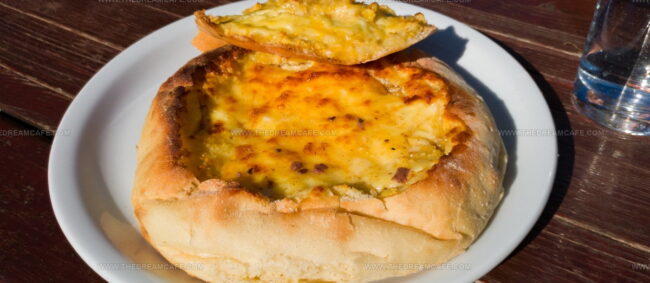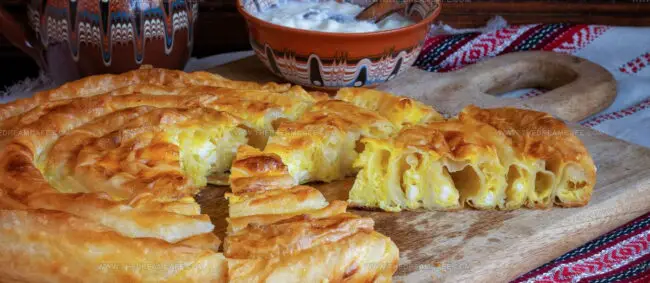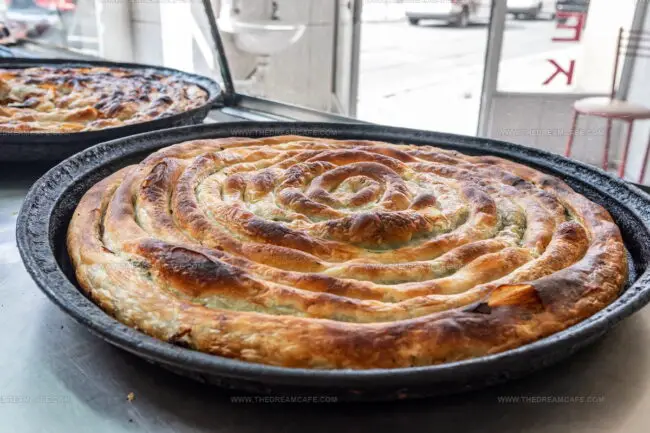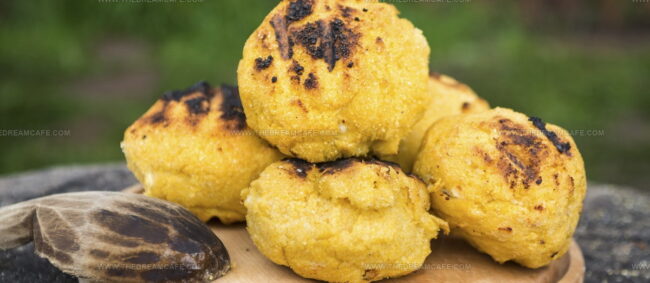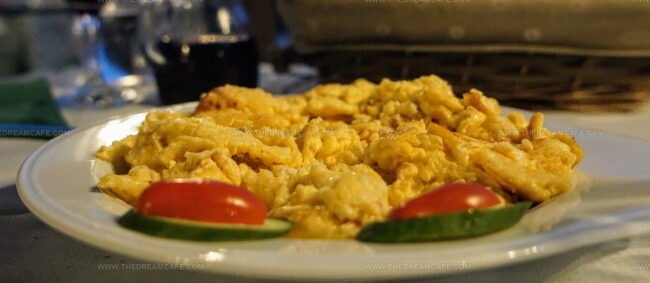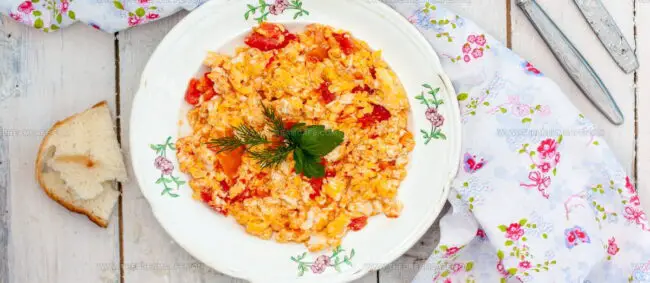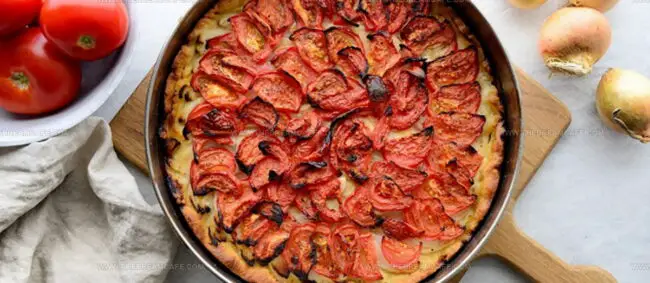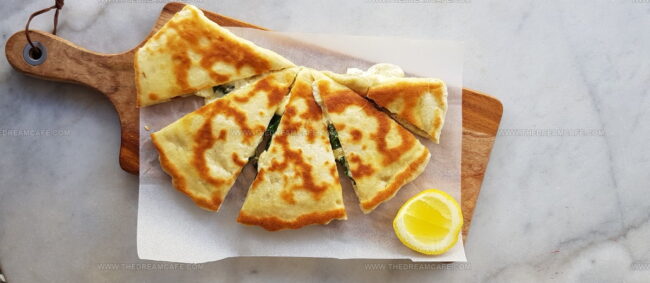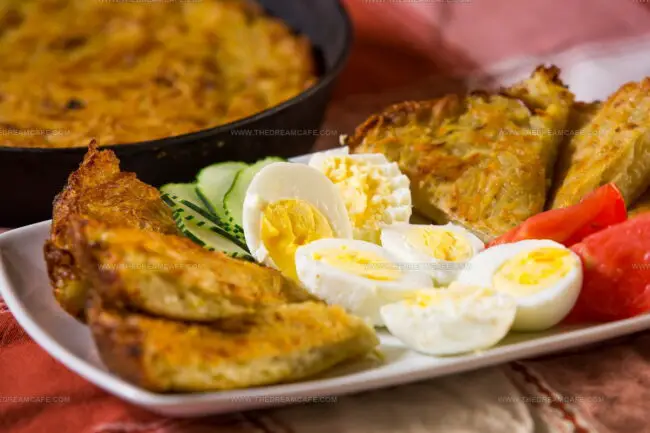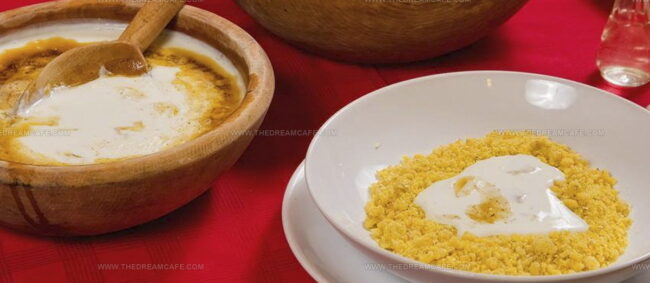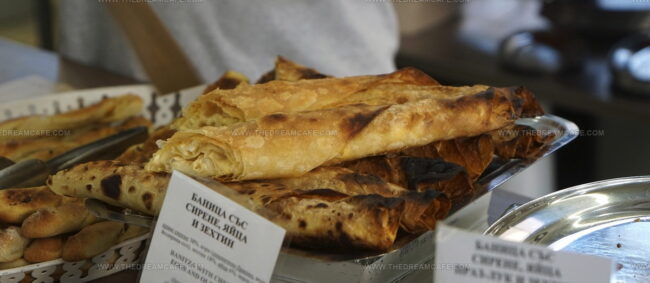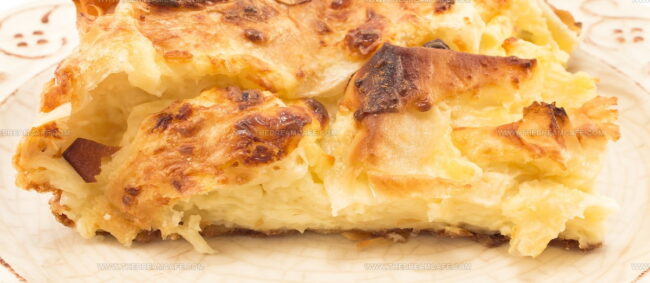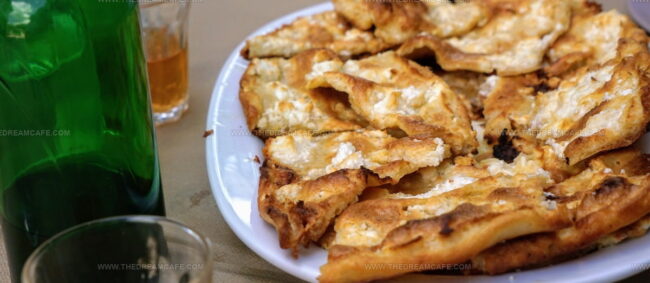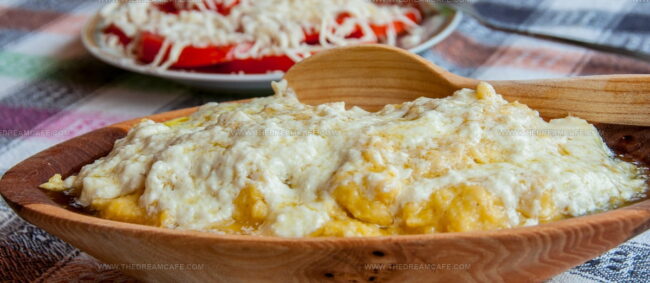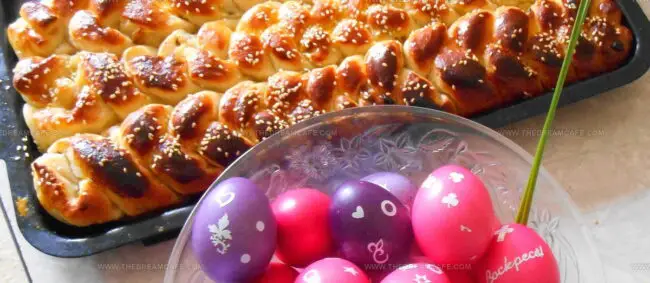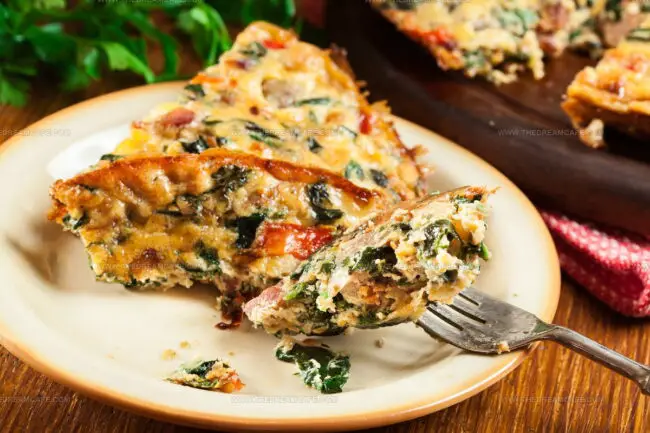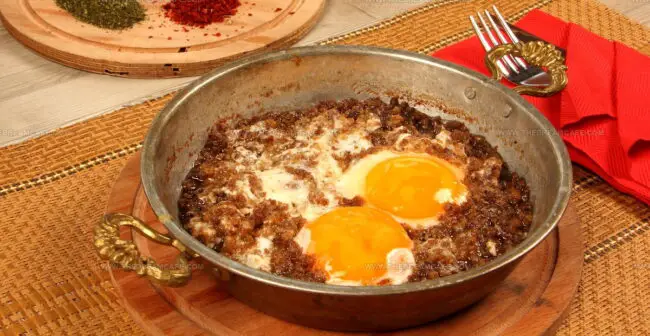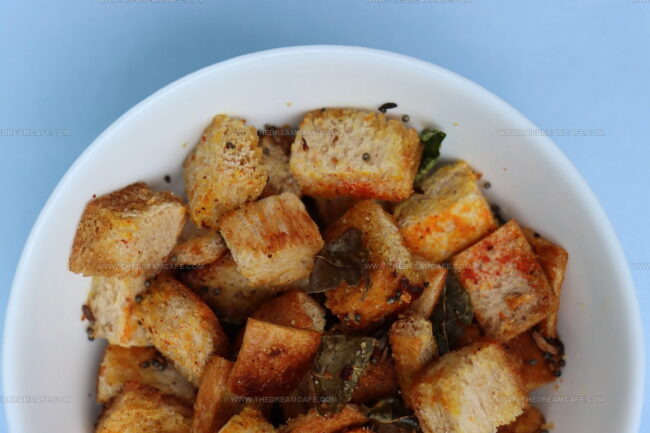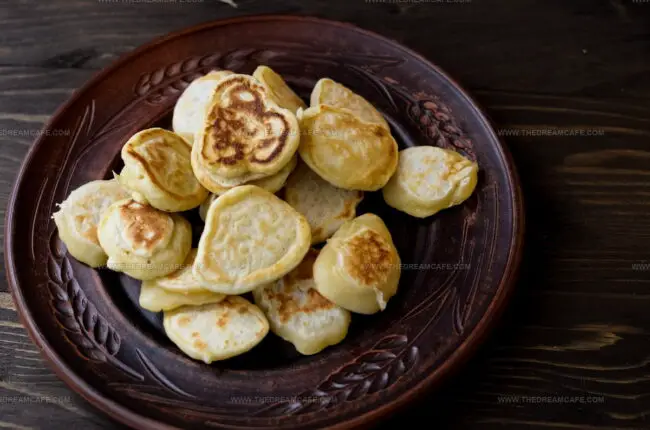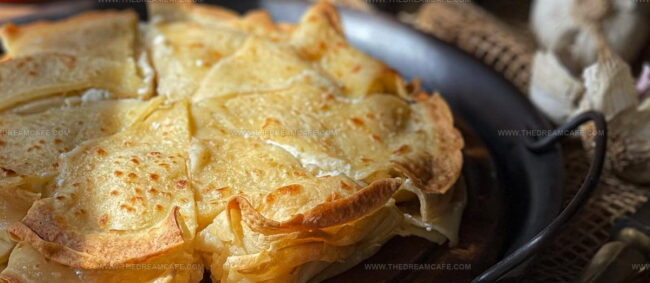43 Yummy Southeastern European Breakfasts to Start Your Day
Southeastern European breakfasts represent a vibrant culinary landscape where morning meals burst with rich cultural heritage and remarkable flavors.
Traditional recipes passed through generations reflect deep connections to regional agricultural practices and local ingredients.
Regional kitchens transform simple components into extraordinary morning experiences that nourish both body and soul.
Hearty preparations showcase remarkable diversity across different communities and terrains.
Each morning ritual tells a unique story of comfort, tradition, and familial warmth.
Regional cooks understand how breakfast transcends mere sustenance, becoming a powerful expression of cultural identity.
Passionate food lovers appreciate these morning traditions as more than just meals.
We invite you to uncover the delectable world of 43 delicious Southeastern European breakfasts that will tantalize your taste buds:
Southeastern European Breakfast Delights
Warm bakeries and bustling kitchens start the day with comforting breakfasts in Southeast Europe. Pastries, cheeses, and spreads offer plenty of variety.
Komplet Lepinja
Komplet lepinja are a mouthwatering Serbian street food featuring a unique flatbread sandwich packed with flavor and regional culinary heritage.
Originating in Uzice before World War II, this hearty dish combines lepinja bread sliced and layered with rich kajmak cream and a fresh egg.
Bakers traditionally drench the sandwich with warm meat drippings called pretop, creating a succulent and satisfying meal.
Regional specialties often feature this classic street food as a signature breakfast or quick lunch option.
Dragan Lazic officially registered the dish's name, cementing its cultural significance in Serbian cuisine.
Meat drippings add intense savory notes to the creamy, egg-filled bread.
Bougatsa
Bougatsa stands as a cherished Greek pastry featuring crispy phyllo layers wrapped around smooth semolina custard, originating from Byzantine Constantinople's culinary traditions.
Greek bakers meticulously craft this delicate pie by hand-rolling thin phyllo sheets and filling them with creamy custard or optional savory ingredients like minced meat or cheese.
Derived from the Ottoman word pogatsa, bougatsa emerged during a period of cultural exchange between Greek and Turkish populations in Northern Greece.
Serres and Thessaloniki became famous for perfecting this flaky pastry, which reflects the region's rich gastronomic heritage.
Immigrants from Turkey significantly influenced bougatsa's development, introducing diverse filling techniques and flavor profiles.
Skilled bakers carefully layer delicate phyllo sheets to create a crisp exterior that contrasts with the soft, smooth interior.
Each region offers its unique twist on this classic breakfast or snack item.
Banitsa With Cheese (Banitsa Sas Sirene)
Banitsa serves as Bulgaria's iconic layered pie crafted from buttered phyllo pastry and filled with a creamy mixture of eggs, yogurt, and traditional sirene or feta cheese.
This beloved national dish originated as a festive Christmas and New Year's Eve delicacy but now appears year-round in grocery stores, street kiosks, and bakeries across Bulgaria.
Baking soda often enhances the recipe, creating a fluffier texture and richer flavor profile that distinguishes this pastry from similar Mediterranean dishes.
Bulgarians enjoy multiple variations, including savory versions with vegetables and sweet adaptations featuring fruits.
Each layer of phyllo represents careful culinary craftsmanship, with thin sheets carefully buttered and stacked to create a crisp, golden exterior.
Regional differences contribute unique ingredients and preparation techniques, making every banitsa slightly unique.
Banitsa With Cabbage (Zelnik)
Zelnik stands as a beloved North Macedonian savory pie featuring multiple filling options like cheese, spinach, eggs, meat, leeks, and cabbage.
Bakers carefully brush the pastry with butter and oil to create a golden-brown exterior that crisp and entices hungry diners.
Home kitchens and bakeries across North Macedonia prepare this versatile dish with regional ingredient variations.
Warm serving temperature enhances the pie's rich taste and flaky texture.
Family gatherings often feature zelnik as a central meal component.
Yogurt serves as the classic accompaniment, balancing the pie's robust flavors.
Regional recipes pass through generations, maintaining the dish's authentic culinary heritage.
Burek
Burek embodies a culinary masterpiece of layered phyllo dough packed with savory fillings that originated in Turkey but became a cultural icon in Bosnia and Herzegovina.
Traditionally filled with ground beef, this versatile dish also comes in cheese, spinach, and potato variations with distinct local names.
Bosnian bakeries typically roll burek into a distinctive snail-like shape, while restaurants serve it pie-style cut into quarters.
Bosnian culture holds burek in such high regard that local wisdom suggests a woman's burek-making skills determine her marriageability.
Skilled preparation involves delicate layering of thin pastry sheets with carefully selected ingredients.
Each bite reflects generations of culinary tradition and regional flavor complexity.
Bakeries and home kitchens celebrate this beloved national dish.
Bulz
Bulz is a traditional Romanian cornmeal delicacy featuring grilled polenta balls stuffed with melted cheese and sometimes bacon.
Romanian shepherds originally created this hearty dish over open fires, transforming simple ingredients into a rustic meal.
Cornmeal is carefully shaped into compact balls and filled with creamy branza de burduf, a soft sheep's cheese that melts beautifully during cooking.
Bacon or ham chunks often enhance the filling's richness and flavor profile.
Grilling or pan-frying produces a crispy exterior while maintaining a soft, warm interior.
Salt and butter complement the core ingredients, adding depth to each bite.
The cooking method ensures a slightly charred crust that provides textural contrast.
Shepherds' practical cooking techniques continue to inspire this beloved Romanian street food.
Burek Sa Sirom
Burek sa sirom is a crispy, golden phyllo pastry originating from Turkish culinary traditions and beloved across Balkan regions.
Delicate layers of translucent dough are carefully stacked and brushed with oil, then generously filled with a creamy mixture of eggs and cheese.
Bosnian versions typically feature a coiled shape, while Croatian and Serbian interpretations might appear round and quartered.
Authentic preparation requires skillful stretching of dough into paper-thin sheets, creating a flaky, lightweight texture.
Mediterranean influences shine through the pastry's simple yet robust ingredients of flour, salt, and water.
Generations have enjoyed this comfort food as a satisfying breakfast or snack.
Savory and crisp, burek sa sirom represents a delicious testament to regional culinary artistry.
Sirnica
Sirnica is a traditional Bosnian spiral pie bursting with creamy cheese and egg filling wrapped in delicate phyllo dough.
Bosnian kitchens prepare this savory pastry by spreading thin jufka sheets with a rich mixture of fresh cow cheese, sour cream, and eggs.
Skilled bakers carefully roll the dough into a distinctive spiral shape that creates multiple layers of flaky texture.
Generations have enjoyed sirnica as a versatile meal suitable for breakfast or light dinner.
Families typically serve the pie with a side of cool yogurt or additional sour cream.
Rural communities often prepare sirnica using ingredients directly from their farms.
Warm or cold, this pie offers a comforting taste of Bosnian culinary tradition.
Staka Me Ayga
Staka me ayga represents a rustic Cretan breakfast delicacy featuring poached or fried eggs nestled in staka, a rich, buttery cream blended with flour unique to Crete's culinary landscape.
Local shepherds traditionally prepared this protein-packed dish using fresh sheep or goat milk products straight from their mountainous pastures.
Seasoned simply with salt and pepper, the eggs complement the creamy staka's smooth texture and intense flavor profile.
Apaki, a traditional smoked pork, frequently accompanies this hearty morning meal, enhancing its savory appeal.
Cretan families have enjoyed this straightforward yet satisfying meal for generations, reflecting the island's pastoral heritage.
Shepherds and farmers initially developed this recipe as a quick, nutritious breakfast to sustain them during long working hours.
Strapatsada
Strapatsada is a rustic Greek egg dish bursting with fresh tomato flavors and simple Mediterranean ingredients.
Mediterranean home cooks create this quick breakfast or brunch meal by sautéing diced tomatoes with olive oil and seasoning them with herbs like oregano and basil.
Fresh eggs are gently stirred into the tomato mixture, creating soft scrambled eggs with a vibrant red color and rich taste.
Feta cheese crumbles add a salty, tangy finish to the dish, enhancing its traditional Greek profile.
Greeks prepare this versatile recipe throughout the Ionian islands and mainland regions as a quick meal or side dish.
Each region adds its unique touch to this classic Greek comfort food.
Mekica
Mekitsa are fluffy, golden-brown Bulgarian breakfast pastries deep-fried until crispy and puffy.
Bulgarian families traditionally prepare these soft breads using simple ingredients like flour, water, salt, eggs, and yogurt.
Mekitsa emerge golden and light with a slightly crisp exterior and tender interior.
Breakfast tables frequently feature these pastries served alongside white cheese, jam, or honey.
Rural households often make mekitsa as a weekend morning treat.
Generations have passed down this classic breakfast recipe through family traditions.
Sfakianopita
Sfakianopita are delicate Cretan cheese pies originating from Sfakia region that combine thin unleavened dough with soft white whey cheese in a unique culinary experience.
Shepherds in Crete traditionally crafted these thin, pancake-like circles by kneading flour, olive oil, water, salt, and raki into a smooth dough integrated with mizithra cheese.
Frying transforms the mixture into a golden, crispy disk with spotted edges that highlight its rustic charm.
Warm sfakianopita become irresistible when drizzled with local thyme honey, creating a perfect sweet-savory balance.
Cooks often sprinkle additional toppings like sesame seeds, cinnamon, or almond slivers to enhance the flavor profile.
Greeks consider this specialty a beloved breakfast treat that showcases Cretan agricultural traditions.
Each bite delivers a rich, complex taste connecting generations of island cuisine.
Placinta Aromana
Placinta aromana stands as a quintessential Romanian pastry bursting with rustic flavors from Moldova and Wallachia regions.
Regional bakers craft this savory pie by layering thin pastry sheets generously brushed with lard and filled with a creamy mixture of eggs, cheese, and either spinach or leeks.
Skilled hands carefully spread the vegetable and egg filling across the delicate dough before covering it with another pastry layer.
Baking transforms the pie into a golden-brown delicacy with crispy edges and a soft, rich interior.
Romanian families traditionally prepare placinta aromana during seasonal gatherings and local celebrations.
Generations have passed down this recipe through careful preparation and shared meals.
Warm from the oven, the pie offers a comforting blend of simple ingredients that reflect Romania's agricultural heritage.
Each slice tells a story of rural culinary traditions and family connections.
Ladenia
Ladenia is a rustic Greek flatbread originating from Kimolos island, featuring a crispy base topped with fresh tomatoes, sliced onions, and generous streams of extra virgin olive oil.
Venetian influences shaped this simple yet flavorful dish during historical occupations of the Cycladic region.
Bakers craft the bread using basic ingredients like flour, yeast, water, and salt, sometimes incorporating olive oil into the dough.
Homemade tomato paste serves as an alternative when fresh tomatoes are unavailable.
Traditional recipes maintain a minimalist approach, though some cooks experiment by adding capers or peppers.
Preparation involves spreading tomato slices and onions across the stretched dough before baking until golden.
Resembling a pizza-like creation, ladenia represents the authentic culinary spirit of Greek island communities.
Greeks consider this dish a beloved street food and casual meal that highlights the pure, fresh ingredients of Mediterranean cuisine.
Krompirusa
Bosnian potato pita reveals a hearty pastry crafted with delicate phyllo dough called jufke, wrapping a savory filling of diced potatoes and optional grated onions.
Originating in Bosnia, this traditional dish showcases simple ingredients transformed into a satisfying meal.
Phyllo sheets are meticulously layered and rolled to create a flaky exterior that contrasts with the soft potato interior.
Seasoned with local spices, the pita offers a comforting and rustic flavor profile.
Each slice provides a glimpse into Bosnian culinary traditions.
Families often prepare this dish using generations-old techniques passed down through time.
Baked until golden brown, the potato pita serves as a versatile comfort food enjoyed throughout the day.
Tiganopsomo
Tiganopsomo represents a crispy Greek fried bread originating from traditional Mediterranean cuisine.
Greek families prepare this versatile dish by rolling wheat flour dough into circular shapes and stuffing the center with crumbled feta cheese and aromatic herbs like oregano, rosemary, and mint.
Olive oil plays a crucial role in creating its signature golden, crispy texture during frying.
Skilled bakers often customize the bread by adding different herb combinations or cheese varieties such as mizithra.
Sesame seeds frequently garnish the surface, enhancing its visual and flavor profile.
Greeks typically enjoy tiganopsomo as a breakfast item or quick snack.
Kljukusa
Kljukusa embodies rustic Bosnian comfort food with its simple Ottoman-era potato pie crafted from basic ingredients like flour, salt, water, and grated potatoes.
Bosnian families traditionally prepare this hearty dish in round pans, creating a thin, crispy pastry with soft potato filling.
Eggs provide additional richness to the mixture, while optional ingredients like garlic, sour cream, or milk enhance its flavor profile.
Toppings range from melted butter and sour cream to fresh cheese and milk, adding layers of creamy complexity.
Ottoman culinary influences shine through this unpretentious yet satisfying peasant dish.
Generations have cherished kljukusa as a comforting meal that connects them to their cultural heritage.
Pura S Lucinicom
Pura s lucinicom stands as a hearty cornmeal specialty from Herzegovina, featuring finely ground corn flour milled traditionally by water-powered mills.
Regional farmers prepare this rustic dish by mixing corn flour with water and cooking it into a smooth, dense base.
Homemade sour milk transforms the simple mixture, creating a rich and tangy topping enhanced with melted butter and crushed garlic.
Villagers enjoy this versatile meal throughout the day, serving it as a satisfying breakfast, lunch, or dinner option.
Mountain communities have sustained themselves with this nutritious preparation for generations.
Herzegovina's rural landscape provides the perfect backdrop for this authentic culinary tradition.
Families pass down the recipe from one generation to the next, maintaining its cultural significance.
Mediterranean and Balkan influences shine through in this uncomplicated yet flavorful dish.
Banitsa
Banitsa is a beloved Bulgarian phyllo pastry layered with creamy eggs, yogurt, and white cheeses like sirene and feta, representing a cornerstone of traditional cuisine.
Sweet interpretations expand the dish's versatility, introducing pumpkin-based tikvenik, apple variations, and mlecna banitsa soaked in milk, eggs, sugar, and vanilla.
Phyllo pastry provides a delicate, flaky foundation for these diverse fillings.
Bulgarian households prepare banitsa for special occasions and everyday meals.
Generations have passed down recipes, preserving cultural culinary traditions.
Gibanica
Gibanica is a savory Serbian pastry layered with phyllo dough and creamy cheese, featuring a rustic texture that captures the essence of Balkan comfort food.
Guzvara, the most popular version, involves soaking phyllo sheets in a rich mixture of fresh cow's cheese and eggs.
Bakers carefully layer and fold the sheets to create a crumpled, casserole-like presentation.
Homemade versions often use traditional yeast dough instead of phyllo, enhancing the pie's rustic character.
Professional bakeries and home kitchens prepare this dish for family gatherings and special occasions.
Serbia claims primary cultural ownership of gibanica, making it a significant national culinary symbol.
Regional ingredients and cooking techniques contribute to the pastry's diverse and complex flavor profile.
Koulouri Thessalonikis
Koulouri Thessalonikis represents a beloved Greek street bread characterized by its signature ring shape covered in golden sesame seeds.
Greek refugees from Asia Minor originally introduced this circular wheat flour bread to Thessaloniki during historical migrations.
Bakers craft the dough into a distinctive round shape before generously coating it with sesame seeds.
Baking transforms the bread into a crispy, golden-brown treat perfect for quick morning breakfasts or midday snacks.
Street vendors throughout northern Greece sell these affordable and portable breads to locals and tourists.
Mediterranean bakeries consider koulouri a traditional staple with roots tracing back to Byzantine times.
Sesame seeds provide a nutty crunch that complements the bread's soft interior.
Greeks enjoy this simple yet satisfying street food as a quick and nutritious meal option.
Zeljanica
Bosnian spinach burek is a beloved Balkan pastry crafted from delicate phyllo dough wrapped around a creamy spinach and cheese mixture.
Skilled bakers carefully roll thin dough sheets called jufka to create its signature spiral shape.
Fresh cow cheese, blanched spinach, cream, and eggs form the rich, savory filling that gives the pastry its distinctive flavor.
Generations of Bosnian families have perfected this traditional recipe passed down through generations.
Home kitchens and bakeries throughout Bosnia and Herzegovina prepare this comforting dish with precision and care.
Each burek showcases the art of layering and rolling dough into a beautiful spiral that turns golden brown when baked.
Crispy exterior and soft, creamy interior make this pastry a beloved staple of Balkan cuisine.
Alevropita
Kotopita is a crispy Greek savory pie originating from Epirus, featuring a thin, unleavened batter crafted with wheat flour, milk or yogurt, and eggs.
Feta cheese generously sprinkled across the surface creates a signature tangy flavor profile.
Bakers carefully spread the delicate mixture into a baking pan, ensuring an even coating.
Rural Greek households traditionally prepare this rustic dish using simple, fresh ingredients.
Its golden-brown crispy texture makes it a popular comfort food.
Mediterranean culinary traditions shine through this uncomplicated yet satisfying pie.
Strandzhanka
Strandzhanka is a savory Bulgarian street snack featuring bread topped with seasoned minced meat that originated in the Burgas coastal region.
Bulgarian culinary traditions inspired this simple yet flavorful dish prepared with locally sourced ingredients.
Bakers spread thin layers of seasoned ground meat across bread slices before baking or grilling them to crispy perfection.
Regional spices like savory, black pepper, and paprika enhance the meat's rich flavor profile.
Bread serves as the perfect base for this hearty protein-packed treat.
Locals enjoy strandzhanka as a quick meal or casual snack during social gatherings.
Street vendors and small bakeries frequently prepare this traditional specialty.
Omeleta
Omeleta represents a quintessential Greek-style omelet bursting with Mediterranean flavors, distinguishing itself from classic omelets by integrating fresh ingredients directly into whisked eggs instead of using traditional fillings.
Crumbled feta cheese provides a tangy, creamy foundation that elevates the dish's unique character, while colorful vegetables like tomatoes, bell peppers, and zucchini create a vibrant taste profile.
Kalamata olives contribute a distinctive briny depth, complemented by aromatic herbs such as oregano and parsley that infuse the omelet with authentic Greek essence.
Cooking the vegetables in olive oil before adding eggs ensures a rich, fruity undertone and allows ingredients to blend seamlessly.
Preparing the dish involves carefully sauteing vegetables until softened, then gently pouring beaten eggs mixed with herbs and cheese over the mixture.
Salt and pepper season the eggs, enhancing the overall flavor complexity.
Mediterranean culinary traditions shine through this simple yet sophisticated breakfast or brunch option.
Placinta Cu Cartofi
Placinta cu cartofi represents Moldova's beloved potato-filled pastry crafted from thin dough and generously stuffed with creamy mashed potatoes.
Moldovan families traditionally fry these golden-brown patties in hot oil or lard until crispy and perfectly caramelized.
Skilled home cooks enhance the potato filling with grated cheese, sautéed onions, and aromatic spices for rich flavor complexity.
Generations have enjoyed this satisfying street food and home-cooked comfort meal throughout Moldova's countryside and urban regions.
These circular pastries provide a hearty, portable meal that travelers and workers appreciate for quick sustenance.
Rural kitchens often prepare placinta cu cartofi using ingredients directly from their gardens and farmsteads.
Ingredients like potatoes, wheat flour, and fresh dairy create a simple yet deeply satisfying dish.
Gogosi
Gogosi are Romanian deep-fried pastries crafted from a simple dough mixture enhanced with vanilla and citrus zest, creating unique irregular shapes through a traditional spoonfuls-in-hot-oil technique.
Bakeries and supermarkets widely sell these treats, often dusted generously with powdered sugar.
The dough excludes yeast and butter, giving gogosi a distinct texture and lightweight feel.
Versatile serving options include filling these pastries with fruit jams or chocolate for added sweetness.
Romania's culinary landscape embraces gogosi as a beloved street food and homestyle dessert.
Warm temperature enhances their crispy exterior and soft interior, making them irresistible to locals and tourists.
Spontaneous gatherings often feature these simple yet satisfying pastries as a quick, delightful snack.
Mish-Mash
Shakshuka is a Mediterranean breakfast skillet originating from North Africa that blends eggs poached in a spicy tomato and pepper sauce.
Bulgarian variations showcase local white cheese melted into the rich, vibrant mixture of sauteed onions and ripe summer vegetables.
Seasoned with salt and black pepper, this one-pan meal offers a hearty protein-packed experience for breakfast or brunch.
Restaurants and home cooks across Eastern Europe and the Middle East prepare the dish with regional ingredients and personal twists.
Mediterranean cultures have enjoyed this simple yet satisfying meal for generations.
Diners typically scoop the sauce and eggs with fresh bread or pita.
Versatile and quick to prepare, shakshuka provides a flavorful start to any morning.
Popara
Popara is a traditional Balkan bread-based dish that transforms leftover bread into a quick, nourishing meal through simple ingredients and creative preparation.
Originating from rural households seeking economical sustenance, this versatile dish combines diced bread with liquid like milk, water, or tea to create a soft, comforting mixture.
Bulgarians, Serbs, and other Balkan communities prepare popara using various techniques, adding butter, oil, or lard for richness.
Savory versions incorporate ingredients such as onions, garlic, ground red pepper, and cottage cheese, while sweet variations might include sugar or honey.
Regions across the Balkans have developed unique interpretations, reflecting local culinary traditions.
Families often prepare popara as a budget-friendly breakfast or hearty snack.
Kitchen resourcefulness shines through this dish, which turns humble bread into a satisfying meal.
Generations have enjoyed popara as a testament to traditional cooking's ingenuity.
Kacamak
Kacamak orbakrdani represents a rustic Balkan cornmeal dish boiled in salted water until thick and creamy, similar to polenta.
Mountain communities in Serbia, Montenegro, North Macedonia, and Bosnia traditionally prepare this hearty staple by stirring cornflour continuously until it reaches a smooth consistency.
Melted butter or pork fat gets folded into the hot mixture, enhancing its rich flavor profile.
Locals frequently serve kacamak for breakfast alongside white cheese, yogurt, sour cream, or kaymak.
Farmers and rural families consider this dish a filling, economical meal that provides substantial energy.
Mountainous regions rely on this simple yet nutritious preparation as a fundamental component of their traditional cuisine.
Generations have maintained this straightforward cooking method, passing down techniques from one family to another.
Kozinjak
Kozinjak ormilibrod emerges as a luscious yeasted bread masterpiece that weaves Romanian and Bulgarian holiday traditions through its soft, thread-like texture and intricate braiding technique.
Sweet rum-soaked raisins nestle inside a golden-brown dough enriched with fragrant citrus zest, creating a sensory experience that transforms simple ingredients into a festive delicacy.
Bakers meticulously brush the braided loaf with egg yolk and milk, ensuring a glossy exterior that hints at the bread's luxurious interior.
Sugar generously sprinkled on top forms a delicate crystalline crust that adds delightful crunch and sweetness.
Poppy seeds and fruit jams frequently complement the traditional raisin filling, offering variations that delight family gatherings.
Primarily prepared for Easter and Christmas celebrations, kozinjak connects generations through its time-honored recipe.
Regional bakers in Romania and Bulgaria craft this bread with deep respect for culinary heritage.
Rizogalo
Rizogalo stands out as Greece's beloved creamy rice pudding, traditionally simmered with simple ingredients to create a silky smooth dessert beloved across Mediterranean households.
Milk and rice slowly meld together over gentle heat, producing a luxurious texture that defines this classic treat.
Short-grain rice ensures maximum creaminess while whole milk provides rich depth and smoothness.
Cinnamon often sprinkles the surface, adding warm aromatic notes that complement the pudding's gentle sweetness.
Greeks typically serve rizogalo chilled in small ceramic bowls, making it a refreshing option for warm afternoons.
Vanilla extract sometimes enhances the pudding's subtle flavor profile.
Sugar balances the creamy base, creating a comforting dessert enjoyed from breakfast to late-night snacking.
Katmi
Katmi are traditional Bulgarian pancakes boasting a unique spongy texture distinguished by small surface bubbles that brilliantly absorb fillings and toppings.
Bulgarian bakers create these thicker crepe-like pancakes using a simple batter of flour, eggs, milk, yeast or baking soda, and salt, sometimes adding yogurt for extra tang.
Griddle cooking on a special "sach" or non-stick pan transforms the mixture into soft, airy pancakes with distinctive porous surfaces.
Generations have enjoyed katmi with classic toppings ranging from sweet honey and jam to savory cheese and minced meat.
Resting the batter allows natural fermentation and enhances the pancake's signature texture.
Modern interpretations embrace both traditional and contemporary flavor combinations.
Warm serving highlights the pancake's soft, comforting qualities and versatile nature.
Mamaliga Cu Lapte
Mamaliga cu lapte are Romanian cornmeal porridge slices bathed in hot milk, a rustic comfort food deeply rooted in countryside cuisine.
Traditional Romanian families prepare this dish by cooking cornmeal in salted water until achieving a thick, smooth consistency.
Cooks carefully cool and slice the porridge using kitchen string, creating uniform pieces for serving.
Rural households often enjoy this simple meal as a hearty breakfast or light dinner option.
Sweet variations incorporate sugar and fresh fruits for added flavor.
Regional differences exist in preparation techniques across Moldova and Transylvania.
Milk temperature and cornmeal quality significantly impact the dish's overall taste and texture.
Romanian households typically serve mamaliga cu lapte as a quick, satisfying meal that connects generations through its straightforward preparation.
Sfougato
Sfougato is a traditional Greek egg-based dish resembling a crustless quiche or open-faced omelet that transforms simple ingredients into a flavorful Mediterranean specialty.
Greek home kitchens craft this versatile recipe by blending beaten eggs with fresh herbs, vegetables, and regional cheeses like feta and kefalotyri.
Breadcrumbs or crackers provide additional texture to the mixture.
Baked in a shallow dish until perfectly set, sfougato derives its name from the Greek word "sfougari," meaning sponge, due to its unique texture.
Greek families typically prepare this dish as a quick, nutritious meal that highlights fresh seasonal produce.
Olive oil, salt, and pepper enhance the final flavor profile, creating a simple yet satisfying Mediterranean comfort food.
Fetoydia
Fetoydia showcases Greek breakfast innovation with a rustic bread-based dish transforming simple ingredients into a golden, crispy morning delight.
Traditional Greek kitchens prepare this toast by soaking bread slices in creamy milk, ensuring a soft interior.
Eggs provide rich binding and texture when bread gets lightly coated before frying.
Olive oil creates a distinctive Mediterranean flavor profile during the pan-frying process.
Slices turn golden brown when carefully fried on both sides, developing a crisp exterior.
Greeks often serve fetoydia with honey, cinnamon, or a sprinkle of powdered sugar for added sweetness.
Mediterranean breakfast traditions shine through this simple yet satisfying dish that connects generations of Greek families.
Simit-Pogacha
Simit-pogacha defines savory Macedonian street cuisine through its ingenious combination of two classic pastries: a soft bread bun encasing traditional burek filling.
Skopje's signature snack features a hearty bread shell generously stuffed with layers of flaky pie packed with seasoned meat or vegetables.
Regional bakers carefully craft each simit-pogacha by hand, selecting premium ingredients to ensure maximum flavor complexity.
Macedonian bakeries typically prepare the dish using local wheat flour and carefully seasoned meat or vegetable fillings.
Street vendors frequently sell these portable meals as quick lunch options for workers and travelers.
Bakery techniques pass through generations, maintaining authentic preparation methods.
Macedonians consider simit-pogacha a quintessential comfort food that connects contemporary cuisine with historical culinary practices.
Cimbur S Mesom
Cimbur s mesom represents a hearty Bosnian skillet meal featuring ground meat and eggs seamlessly combined in one pan.
Originating from traditional Balkan cuisine, this rustic dish starts with sautéing ground meat alongside chopped onions and fragrant ground paprika.
Tomatoes or tomato sauce often enhance the meat's rich flavor profile during cooking.
Whole eggs are carefully cracked directly over the sizzling meat mixture, creating a stunning visual and flavor experience.
Slow baking allows the eggs to set perfectly, creating a uniform texture that blends protein and seasonings.
Bosnian families frequently prepare this simple yet satisfying meal for breakfast or quick dinners.
Typically served hot from the pan, cimbur s mesom offers a protein-packed dish that connects generations through its straightforward preparation.
Papare
Papare represents a rustic Albanian bread-based comfort food crafted from stale bread pieces expertly fried until golden and crispy.
Versatile in nature, this traditional dish transforms into either sweet or savory variations depending on personal taste preferences.
Sweet versions involve caramelizing bread with sugar and water until fragrant and rich in flavor.
Savory preparations feature crumbled curd cheese like gjize or feta, sometimes enhanced with meat or cheese brine for deeper complexity.
Regional cooks frequently garnish the crispy bread with fresh herbs such as oregano, mint, or spring onions.
Small Albanian households often prepare papare as a quick, economical meal using simple ingredients.
Minimal cooking skills and basic pantry staples make this dish accessible to everyone seeking a comforting, satisfying meal.
Tikvenjak
Tikvenjak is a rustic gourd pie beloved across Croatia and Bosnia for its simple yet delicious preparation involving thin pastry stuffed with sweetened pumpkin or squash.
Bakers roll delicate dough into a strudel-like shape, filling it with grated gourd mixed with sugar, vanilla, and cinnamon.
Seasonal ingredients make this traditional dessert an affordable and quick treat for families and gatherings.
Rectangular or rolled versions emerge golden-brown from hot ovens, offering a crisp exterior and soft, spiced interior.
Generations have passed down the recipe, highlighting its cultural significance in Balkan cuisine.
Pumpkin's natural sweetness reduces the need for excessive sugar, creating a balanced flavor profile.
Served warm or at room temperature, tikvenjak provides a comforting taste of home and heritage.
Lalagites
Lalagites are traditional Greek pancakes from Lemnos, distinguished by their versatile preparation method and rich regional flavor profile.
Greek islanders craft these delicate pancakes using a simple batter of flour, water, eggs, and olive oil, with variations including sugar, yeast, or milk.
Mint leaves and crumbled kalathaki cheese often enhance the basic recipe, creating a unique taste experience.
Frying the batter in hot olive oil produces small, round pancakes that can range from thin crepes to thicker fritter-like textures.
Locals typically serve lalagites drizzled with fragrant thyme honey and sprinkled with cinnamon, transforming them into a sweet and savory treat.
Regional ingredients and cooking techniques give these pancakes a distinctive character that reflects Lemnos' culinary traditions.
Seasonal variations and family recipes add depth to this beloved Greek island dish.
Petulla Te Fshira
Petulla te fshira are unique Albanian pancakes distinguished by their distinctive method of preparing batter by "wiping" it across a cooking surface.
Originating in Albania, these pancakes differ from standard fried dough versions through their specialized preparation technique.
Traditional ingredients include flour, water or milk, yeast, and salt, with some recipes incorporating eggs for additional richness.
Cooks create layers by stacking the pancakes with complementary fillings like garlic, fresh cheese, and olive oil.
Baking follows the layering process, transforming the simple ingredients into a savory dish.
Home kitchens across Albania frequently prepare this comfort food for family meals.
Serving these pancakes often involves cutting into sections and enjoying them warm, highlighting their rustic charm.
Banitsa With Onions (Luchnik)
Luchnik is a savory Bulgarian pastry distinguished by its unique onion and leek filling nestled between delicate filo layers.
Bulgarian bakers traditionally craft this rustic variant of banitsa with carefully sliced onions or leeks spread throughout the pastry's flaky sheets.
Rice and vegetables can provide extra texture and depth to the basic onion mixture.
Skilled home cooks prepare the pastry by carefully layering thin filo dough with the seasoned onion blend.
Each layer receives careful attention to ensure even distribution of ingredients.
Baking transforms the raw ingredients into a golden-brown, crispy-edged delicacy.
Regional Bulgarian families often serve luchnik as a hearty breakfast or satisfying midday meal.
How Common Are Fermented Foods and Pickles in a Traditional Southeastern European Breakfast?
Fermented foods and pickles are a vibrant part of Southeastern European cuisine, and they often play a key role in traditional breakfast meals. Their inclusion reflects cultural habits, flavor preferences, and health benefits. Here’s why these tangy delights are commonly found on the morning table:
Incorporating fermented foods and pickles into breakfast is a delicious way to enjoy centuries-old culinary traditions while benefiting from their healthful properties.

